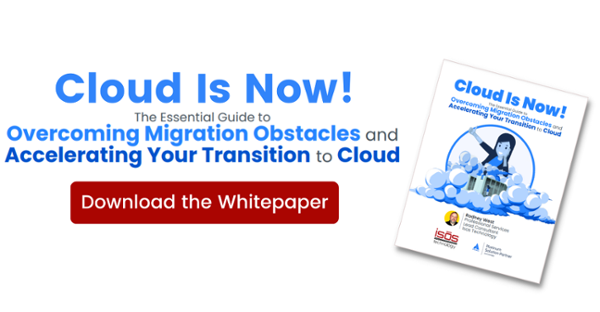Guest Contributor: Deanna Farina
 Chances are you’ve heard the news, support for Atlassian Server products ends on February 15th, 2024. The impending end-of-life date for Server has some companies scrambling to migrate, and not everyone is happy about it. But according to leading technology vendors and IT consultants, there are some valuable benefits to shifting your organization to Atlassian Cloud.
Chances are you’ve heard the news, support for Atlassian Server products ends on February 15th, 2024. The impending end-of-life date for Server has some companies scrambling to migrate, and not everyone is happy about it. But according to leading technology vendors and IT consultants, there are some valuable benefits to shifting your organization to Atlassian Cloud.
First, organizations shift from managing hardware and software to instead focusing on products, services, and customers. Using cloud solutions like Atlassian Cloud, teams can work more efficiently with greater flexibility. Plus, organizations can reduce costs and gain access to critical features like scalability, security, and compliance.
But a successful migration requires careful planning and consideration, and there's more than one path to migration available. Here's what experts from Acceleration Economy, Isos Technology, Atlassian, and Appfire advise as the Atlassian Server "end of life" date quickly approaches.
Read on or jump to a question:
- What are the options for organizations on Atlassian Server between now and 2024?
- What are the potential risks in a Cloud migration?
- What are the benefits of moving to the Cloud ASAP?
- What are best practices for cloud migrations?
- How does Atlassian Cloud help customers empower their mobile workforce?
- How can you maintain security and compliance in a world that’s becoming increasingly risky and complex?
- How can partners help with cloud migrations?
What are the options for organizations on Atlassian Server between now and 2024?
Option 1: Migrate to Atlassian Cloud as soon as possible
Paul Lechner, AVP product management at Appfire, recommends you start planning as soon as possible. "Start to build your plans and explore working with solution partners if you're a more complex customer that needs some help along the way."
Option 2: Do nothing for as long as you can
Another option is to postpone your migration until we get closer to the February 2024 end-of-life date for Atlassian Server. But, whether you initiate the move to Cloud “as soon as possible” or “as late as possible,” you need to start reaching out to solution partners. Many specialized partners have their migrations already scheduled with customers, and you'll want to make sure you can work with your preferred partner when the time comes.
Option 3: Take a hybrid approach
For many organizations, a hybrid approach can work for migration, you can move some of your data immediately to the cloud, then migrate the remaining data in phases.
"Those can be simpler migrations where companies take one department or one location and test out the Cloud now," Paul says. "Looking at those less complex migrations means that customers can take less risk, which might mean they migrate faster initially and then move more of their data as time goes on."
Regardless of which option you choose, Rodney West, sr. professional services lead consultant at Isos Technology, recommends kicking off your assessment process asap to determine which path to Cloud is right for your organization.
"It's going to take time for assessments, to determine the right partner to help you through migration, and then to finally perform the migration. Waiting another few months can really put you behind in terms of identifying features to move to the cloud versus what may be a better fit for Data Center."
What are the potential risks in a Cloud migration?
Waiting too long could result in missing the end-of-life date, and not being able to find necessary resources during migration can cause serious problems.
Rodney also recommends getting a head start on your migration path as soon as possible in order to avoid missing the Server end-of-life date and losing support. Organizations can also minimize risk when migrating by making sure they're well-staffed (both internally and externally with partners) when it comes time to migrate.
Cloud migrations can be very complex, involving significant planning, resource allocation, rehearsals, and multiple UAT cycles.
"Those are very time-consuming, and they require people with expertise and the right tooling. You're going to want an Atlassian Solution Partner by your side. The longer you wait, the smaller that bucket of solution partners is going to be that have availability to move you within a timeframe that fits your needs," Rodney says.
What are the benefits of moving to the Cloud ASAP?
Moving quickly isn’t just about avoiding risk. Moving your systems and data to the cloud sooner rather than later benefits your business.
Benefit 1: Save on maintenance costs
Moving to the cloud has costs and benefits — but many organizations will recoup their costs in migration with the benefits of cloud migration. "When maintaining a Server instance or Data Center instance, there are certain costs that are associated with that. For example, you need to maintain your own hardware, there's specific software you need to maintain, you have patch upgrades, release cycles, you need to have specialized staff and people that are experts at security, authorization, load balancing, and network optimization. All of these have a cost," Paul observes.
According to a Forrester report on Atlassian Cloud, companies who migrate to cloud can reduce hardware maintenance costs by 20%.
Benefit 2: Gain access to cloud-only features and functionality
Moving to the cloud sooner rather than later and embracing Atlassian's cloud-first mentality also brings advantages such as new features introduced in cloud only.
It's important to think "cloud-first" from an app vendor perspective as well, Paul says. "At Appfire, we’re introducing new apps and additional functionality around security that support Atlassian apps in the cloud first."
Benefit 3: Take advantage of discounts while they last
Finally, when conducting your cost analysis, consider the potential discounts available from Atlassian and through partners when it comes to licensing fees.
Dave Heebner, senior solutions engineer for cloud migrations at Atlassian, recommends that organizations take advantage of the limited-time Atlassian Cloud loyalty discounts.
|
Find out how Isos Technology and other migration partners use Atlassian Marketplace apps like Appfire's for a smooth Atlassian Cloud transition and security and compliance boost. Watch on-demand webinar → |
What are best practices for cloud migrations?
Best Practice 1: Invest in the assessment phase
According to migration experts, investing in the assessment phase is critical for successful and smooth migrations.
"While the assessment phase isn't as exciting as the actual migration, you need to invest time in finding out what your business-critical features are organization-wide," Rodney says. What the IT team deems business-critical might be very different from what HR thinks (or legal, marketing, etc.), so reaching a consensus as an organization is key to determining your migration path.
During the assessment phase, you’ll also determine whether Atlassian Cloud is a good fit for your company, or if it makes more sense to invest in Data Center (or take a hybrid path).
Best Practice 2: Don't forget your partners during the assessment phase
"I see migrations that have partners involved and ones that don't, and most of my experience is across our largest customer base. Every time I see issues with migrations, it's because the assessment phase wasn't done properly."
Whether you're a large customer with 35 different Confluence instances or a one-person shop, Dave recommends determining your options for partners and taking the time for a proper assessment phase no matter your team size.
How does Atlassian Cloud help customers empower their mobile workforce?
As more organizations recognize the value of enabling a mobile workforce, they're investing resources into addressing remote work. Atlassian's Cloud architecture is designed to support a mobile workforce by giving teams scalability, flexibility, and control over their IT infrastructure.
"At its core, Atlassian Cloud is the ability for you to leverage and take advantage of all our existing enterprise-wide investments in security and compliance," Dave says. "By allowing Atlassian architecture to handle your security and compliance upfront, you don't have to worry about opening a VPN back into a Confluence server in order to give your mobile workforce access to documentation, for example."
Atlassian's architecture has been tried and tested, and it’s designed to handle system risks while accelerating your team's productivity.
How can you maintain security and compliance in a world that’s becoming increasingly risky and complex?
Tip 1: Collaborate closely with your partners
Opening VPNs, or in the worst case scenario, a port, is an example of the tedious security concerns that raise alarm bells for CIOs like Wayne Sadin, a C-suite and board of directors advisor from Acceleration Economy. Wayne advises that organization leaders collaborate with partners like Atlassian, Appfire, and Isos Technology to streamline any compliance or InfoSec processes during migration.
Tip 2: Work with an enterprise-ready app vendor
As Atlassian is investing in security and compliance initiatives for the Cloud, customers should look to app vendors who are following suit. For example, Appfire gives partners and customers access to a Trust Center.
The Trust Center is a single knowledge base on security, privacy, and compliance for Appfire’s product, and also includes commonly requested pre-completed questionnaires (such as CAIQ, SIG, and VSA), and information about Appfire’s ISO 27001 certification and SOC 2 audit status.
“Having access to a resource like a trust center ensures that as you make the move to Cloud, you're covered compliance-wise,” Paul says.
Tip 3: Involve the appropriate teams early on
“Having spent a few years doing analyses for prepping for cloud migrations, I always tell clients during those first assessment meetings that I want somebody from their Risk or InfoSec teams involved,” Rodney says.
You don’t want to kill a migration in the middle of UAT because your Risk team has suddenly discovered that one of your third-party apps doesn’t meet your company’s compliance needs, according to Rodney.
Compliance is a hot topic during migrations, and Rodney advises companies to enact a solid due diligence model when engaging vendors for third-party apps.
“You want to see if those vendors meet your specific compliance profile. Every organization, even in the same vertical, is going to be different. Different financial companies, while they may have some standards they follow, have specific compliance needs,” Rodney says.
How else can partners help with cloud migrations?
Rodney likes working with Atlassian Solution Partners for migrations to fixing the plumbing in your house.
“You could probably go in and fix the plumbing in your house yourself. You can watch some YouTube videos and try to do stuff. I've replaced sinks myself and later thought, ‘the amount of time I'm spending here is costing me more than it would have cost to pay somebody who knows how to do this — and who knows other contractors if something goes wrong.’”
Relying on the Atlassian partner ecosystem is like having a trusted plumber on hand, Rodney says.
“The partners are the ones who live this day in and day out. We’ve got our strategies and we talk to each other, so we know the complexities of migration. We also have relationships with vendors like Appfire.”
For example, with compliance being such a tricky area, Rodney appreciates Appfire’s portfolio product approach.
“The thing I really like about Appfire's approach is it's more consolidated. I can see what the compliance is across all their apps and I don't have to chase down 10 or 15 different apps — and then potentially have to find an alternative,” Rodney says.
Coupled with the expertise of solution partners, Appfire's Trust Center and Atlassian's trust model make migrations faster, easier, and less risky.
Sign up to receive more great content
Learn more about Atlassian and how Isos can help by signing up to receive our latest blogs, eBooks, whitepapers and more.














